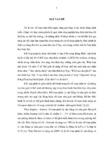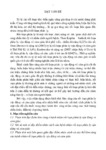
Please use this identifier to cite or link to this item:
http://dulieuso.hmu.edu.vn/handle/hmu/2076| Title: | Nghiên cứu đặc điểm lâm sàng và một số đặc điểm nhân cách của bệnh nhân rối loạn phân ly vận động và cảm giác |
| Authors: | Vũ Thy, Cầm |
| Advisor: | PGS.TS. Nguyễn Kim, Việt PGS.TS. Trần Hữu, Bình |
| Keywords: | 62720148;Tâm thần |
| Abstract: | THÔNG TIN TÓM TẮT VỀ NHỮNG KẾT LUẬN MỚI. CỦA LUẬN ÁN TIẾN SĨ. 1. Đặc điểm lâm sàng rối loạn phân ly vận động và cảm giác . - Giới: nữ nhiều hơn nam (tỷ lệ nữ/nam = 4,48/1).. - Bệnh thường gặp ở tuổi trẻ: 65,22% < 30 tuổi, sau 40 tuổi chỉ gặp ở 13,04%.. - Rối loạn phân ly vận động và cảm giác xuất hiện đột ngột ở 100% các trường hợp nghiên cứu. Một tỷ lệ cao rối loạn phân ly vận động và cảm giác xảy ra sau sang chấn tâm lý (86,08%).. - Triệu chứng vận động thường gặp nhất là co giật phân ly (74,78%); triệu chứng cảm giác thường gặp nhất là đau (72,17%).. - 73,04% số bệnh nhân thuyên giảm hoàn toàn sau điều trị; 60% số bệnh nhân có thời gian điều trị ngắn ≤ 2 tuần.. 2. Một số đặc điểm nhân cách của bệnh nhân rối loạn phân ly . - Rối loạn phân ly thường xảy ra ở những người có tính cách dễ bị ám thị (88,7%), dễ xúc động (80,87%), thích phô trương (63,48%).. - Một tỷ lệ cao bệnh nhân rối loạn phân ly có xu hướng nhân cách không ổn định (82,41%) theo trắc nghiệm tâm lý Eysenck.. - 50,51% số bệnh nhân có điểm số thang Hy ở mức bệnh lý theo trắc nghiệm tâm lý MMPI.. 3. Mối liên quan giữa đặc điểm nhân cách và các thể lâm sàng của bệnh nhân rối loạn phân ly vận động và cảm giác. - Không có sự khác biệt giữa yếu tố hướng nội – hướng ngoại và yếu tố ổn định – không ổn định của trắc nghiệm tâm lý Eysenck ở các thể bệnh.. - Điểm trung bình thang Hy của trắc nghiệm tâm lý MMPI của các thể bệnh từ 64 ± 16,64 đến 68,62 ± 14,51 và không có sự khác biệt giữa các thể bệnh (p > 0,05).. - Có sự tương quan tuyến tính của điểm số thang Hy giữa các thể lâm sàng với các mức độ khác nhau.. SUMMARY INFORMATION ABOUT THE NEW CONCLUSIONS OF DOCTORAL THESIS. The new conclusions of thesis:. 1.Clinical features of dissociation disordersof movement and sensation. - Gender: Women are higher than men (ratio of female/male = 4,48/1).. - The disease is common in young age: 65,22% of patients < 30 years, only 14,04% of patients ≥ 40years.. - Dissociation disorders of movement and sensation suddenly appear in 100% of studied cases. A high rate of dissociation disorder of movement and sensation occurs after psychological stress (86,08%).. - The most common of motor symptoms are the convulsion dissociation (74,78%).. - The most common of sensation symptoms are pain (72,17%).. - 73,04% of patients remiss completely after treatment; treatment duration of 60% of patients is shorter than ≤ 2 weeks.. 2. Some personality characteristics of dissociative disorder patients. - Dissociation disorders usually occur in people who are susceptible to suggestion (88,7%), excitation (80,87%), ostentation (63,48%).. - There is a high rate of dissociation disorder patients who tend unstable personality (82,41%) according to Eysenck psychological testing.. - 50,51% of patients who have Hy scale scores at pathology level (> 70) according to the MMPI psychological test.. 3.The relationship between personality characteristics and the clinical types of dissociation disorder of movement and sensation. - There is no difference between introvert-extrovert factors and stable-unstable factors in Eysenck psychological test among clinical types .. - The Hy scale of average scores in MMPI psychological test are from 64 ± 16,64 to 68,62 ± 14,51 and there is no difference among clinical types (p > 0,05).. - There is a linear correlation among Hy scale scores in the clinical types with different levels.. |
| URI: | http://dulieuso.hmu.edu.vn//handle/hmu/2076 |
| Appears in Collections: | Luận án (nghiên cứu sinh) |
Files in This Item:
| File | Description | Size | Format | |
|---|---|---|---|---|
| 58_LA.pdf Restricted Access | 1.69 MB | Adobe PDF |  Sign in to read | |
| 58_TT 24 trang.pdf Restricted Access | 712.45 kB | Adobe PDF |  Sign in to read |
Items in DSpace are protected by copyright, with all rights reserved, unless otherwise indicated.